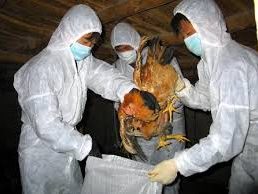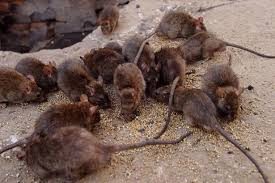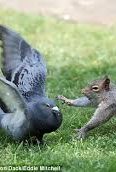|
The Dangers of Allowing Wild Birds and Rats in Your Chicken’s Feed |
Bird Flu or Avian Flu
Are you worried about bird flu or Avian flu is spread by wild birds? With the outbreak of Bird Flu in early 2015 it is very important to prevent wild birds from sharing feed and water with your flock. Authorities in several states have already begun testing and euthanizing backyard chicken flocks and it is reported that they will test flocks up to seven miles from any outbreak. A wild bird proof chicken feeder is cheap insurance that your flock will not be exposed. If you are having problems with wild birds like starlings, house sparrows, English sparrows, pigeons, or grackles this is the solution.
Avian Influenza is also called Bird Flu but that is a bit misleading because there are different strains of the virus and mutations of the virus so in reality there are many forms of Bird Flu. The term Avian Influenza also refers to those forms of the virus that are adapted to birds, forms that are carried by birds but are seldom lethal to the wild birds, and those forms of the virus that can cross over into humans. The outcome can range from a simple case of flu, respiratory failure, pneumonia, or conjunctivitis. Wild birds and chickens aren’t a good mix.
The two common bird flu viruses are H5N1 and H7N9 and most of the time the birds are carriers but generally will have immunity but domestic poultry will get sick and even the they don’t die they will have to be destroyed to stop the spread of the virus. People seldom get these two types of bird flu virus and when they do it is usually people that live in close contact with the birds, sometimes living and sleeping with infected domestic poultry.
Even rarer are cases where bird flu has passed from human to human and while the numbers of people that have developed the disease is small the mortality rate is appalling. What scientists really fear is that the virus mutations are so very different from regular flu viruses that we won’t have immunity against the virus. Consider the American Indian population that was wiped out after European visitors showed up in the New World.
But is the danger that real? Looking back in history shows that there have been many viruses that mutated from birds but only three grew into pandemics. First was the 1957 H2N2 virus that mutated from avian and human viruses. Then in 1968 N3N2 erupted into a pandemic. But the scariest form of avian flu was the infamous “Spanish Flu” of 1918 that killed a half million Americans and 50 million across the world.
The most recent epidemic in recent times was in 1997 when H5N1 swept through Hong Kong where 18 people were hospitalized and one third of them died. Hong Kong killed a million and a half chickens in order to eradicate the disease. In addition- and perhaps most frightening is the fact that there were rare situations where this virus spread from person to person in 1997. H5N1 didn’t just cause flu symptoms to appear, it was very aggressive to the point where the patient’s own immune system turned against their own body, reminiscent of the Spanish Flue at the turn of the century. H5N1 has only killed 167 people since 2003 but only about twice that many came down with it.
Thankfully the virus needed an avian host to transfer to humans so infected humans didn’t pass along the infections. Scientists learned that H5N1 laced a protein called hemagglutinin, which is common in common human flu viruses. The protein has a spike that allows it to grab hold of cells in the human nose and throat.
This protein allows a virus to be spread airborne with a sneeze or cough. H5N1 prefers to live in the intestinal tract of birds and that is all that has saved millions if not billions of people throughout the world. But viruses mutate easily and should H5N1 mutate and acquire a hemagglutinin protein coating we would see unstoppable pandemics across the world with as high as 43% mortality rates.
Unfortunately, viruses change all the time. Thus, the virus could mutate to a form that prefers to attach itself to the sinus passages at any time. In fact, the likelihood of a pandemic outbreak from a mutation of H5N1 in the future, according to some scientists, is as high 43%. Outbreaks in Vietnam and Thailand showed that the two most common anti viral medications were useless against H5N1. More worrisome is that the virus has spread to ducks, usually in a low level mutation but there have been dead wild ducks found with a high mortality mutation of the virus.
What States Have Experienced Avian Flu?
As of mid March 2015 here is a partial list of states that have either had an outbreak recently or since 2000 or have made plans to
deal with an outbreak. We will post the missing states as we compile the information.
Alabama
Officials are downplaying any concern but they do warn people to get a flu shot just in case.
Alaska
Sent out advisory to hunters after the reports from Washington and Oregon bird flu cases surfaced.
Arizona
Continues to test humans for potential bird flu cases.
Arkansas
The discovery of a highly pathogenic H5N2 avian flu in turkeys in Arkansas has caused Mexico, Canada, and the European Union to
join China and Korea’s ban on American poultry products. Over 40,000 turkeys in Boon County Arkansas were destroyed in an
attempt to contain the contagion. Arkansas is one of the major poultry producing states and stock prices of the major poultry producers plummeted which in turn is going to result in lobbyists pressuring legislators to increase regulations on backyard chickens and small free range flocks.
California
In January a California turkey flock was quarantined and all of the birds were destroyed after routine testing turned up bird flu. Then in February a second commercial flock was found with infected birds.
Colorado
Hasn’t reported on any out breaks but one Colorado blogger had it right when she pointed out that a single backyard flock turning up infected would create immediate trade sanctions against all poultry product coming from that state.
Connecticut
Is well prepared for an outbreak as one case had been discovered some years ago. Connecticut has a large egg production industry and has programs in place to monitor flocks and diagnose any outbreaks.
Delaware
Had two flocks testing positive back in 2004 which led to testing seventy five flocks around the two commercial operations and poultry
import bans from eleven nations. Delaware immediately destroyed tens of thousands of birds in the two flocks, canceled all meetings of farmers, canceled sales of farming equipment and auctions, and also stopped the sale of live poultry in the state. With a multi billion dollar brooder industry Delaware would take draconian measures to eradicate any outbreaks. One of the farms that had an outbreak, Purdue Farms, blamed a local backyard flock that was raising birds for the New York market One local news story pointed out that a Virginia outbreak led to four months of exterminating flocks, over five million birds slaughtered, before the outbreak was contained.
Florida
Has a large wild bird population but so far there is limited information on any outbreaks or concern.
Georgia
Has been studying bird flu since the early 200’s and has a strong research organization based at the colleges. Like most states it is
monitoring for bird flu but no new cases have been reported.
Hawaii
Has hundreds of thousands of Chinese visitors each year and is very close to Asia so they have been studying the bird flu but there are no reports of any poultry outbreaks.
Idaho
In Mid January Idaho confirmed a case of backyard chickens infected with bird flu after some falcons died of the disease. The farm was about twenty miles from the falconry and the farm was quarantined and the flock euthanized immediately.
Illinois
Has yet to suffer any outbreak of bird flu but health officials and universities are monitoring any suspicious poultry deaths.
Indiana
Has not reported any outbreaks but has contingency plans in place should an outbreak occur.
Iowa
One local story pointed out the connection between backyard flocks and disease: “Also, and Thompson says this is critical, all his turkeys live indoors. When he started in the business 35 years ago, the turkeys ranged outside. We raised them out in the fresh air and it was just really, really wonderful” he said, “and you are going to hear some sarcasm right now: What was so nice about it was we had all kinds of wild birds swooping in and eating out of the same feeders that the turkeys were eating out of. The wild birds would repay their inadvertent hosts by sharing whatever diseases they were carrying. Say what you will about animal welfare, but moving the birds inside did protect them from those threats. Many small backyard flocks still have contact with wild birds. In fact, that’s what officials think happened in Washington, Oregon and Idaho where they’ve found the highly contagious form of bird flu. Iowa State University professor K. J. Yoon says these cases in the Pacific Northwest were handled exactly as planned.
Kansas
Bird flu has been detected in a backyard flock of chickens and ducks in northeast Kansas. The Kansas Department of Agriculture said in a news release late Friday that the discovery was made in Leavenworth County. Backyard poultry owners in the county are urged to contact the department. Additionally, parts of Cherokee and Crawford counties in the southeast part of the state are under surveillance after a confirmed case of the H5N2 strain of bird flu was found just across the state line in Jasper County, Missouri, this month.
Kentucky
In 2009 bird flu was found on a Kentucky farm, resulting in 20,000 birds being euthanized. The Kentucky Department of Agriculture is
conducted surveillance on backyard flocks within a two-mile radius of the farm after the outbreak.
Louisiana
;Health officials are predicting that the bird flu will make its way to Louisiana. The state immediately ordered a ban on incoming poultry unless they were from tested and verified disease free flocks. The state tests commercial farms and has partnered with the Game and Fish Department to test backyard flocks if needed.
Maryland
Bird flu hit Maryland in 2004 leading officials to kill 325,000 infected birds and another 40,000 that tested negative but were killed because they belonged to one of the farmers than had an infected flock. They tested over 1,000 flocks and some insiders said that they destroyed flocks that tested negative just to reassure foreign countries that they had contained the outbreak.
Massachusetts
Had an outbreak in 2012 that killed some swans but no poultry farms were impacted.
Minnesota is the nation’s top turkey producing state and reported on March 4th that rapid response protocols from the federal government and poultry industry were used. Once H5N2 was confirmed at the farms the surviving turkeys were killed . Officials quarantined the facilities an declared six mile radius restricted zones. They tested nearby farms but found no signs of other infected flocks
Mississippi
Has reported no outbreaks but officials are pointing to the Mississippi valley as an avenue that would spread the disease.
Missouri
Officials quarantined two Missouri farms, one in the Southwest, the other in the center of the state. All the turkeys were killed.
Nevada
Confirmed a case of bird flu in late January. However it was a wild duck, a species that usually carries the virus without harm to the host.
New Jersey
Had a low level bird flu outbreak in 2014, leading Hong Kong to outlaw the import of poultry products from one New Jersey county. Four of the 35 live bird markets in New Jersey had birds that tested positive for the disease.


Diseases spread by Rats, Squirrels, and other Rodents
Hantavirus Pulmonary Syndrome, HPS
Caused by a virus spread by mice and rats. Breathing in dust contaminated with rodent urine or droppings, by direct contact with rodents, or from bite wounds.
Hemorrhagic Fever with Renal Syndrome
Spreads in the same manner as above but can be spread from person to person in rare cases. Typically a European and Asian
distribution.
Lassa Fever
Typically in West Africa and caused by the same manners as above as well as food contaminated with rodent urine or droppings. May spread from human to human by contact.
Leptospirosis
Is a world wide problem caused by a bacteria found in food or water contaminated with rodent urine. Dust or water can carry the bacteria through the skin or mucous membranes on contact.
Lymphocytic Chorio-meningitis
Caused by a virus carried by the common house mouse and is found world wide. Same vector as above, contaminated dust, direct contact with rodents or their urine and droppings, or bite wounds.
Plague…. And yes, that is Bubonic Plague
Caused by a rodent carried flea that harbors bacteria and is found in Africa, Asia, South America, and Western United States. You have to be bitten by a flea or in direct contact with an infected animal. Carried by most wild rodents like squirrels, rats, prairie dogs, and chipmunks.
Rat bite fever
Caused by bites or scratches from rats and mice and is world wide. Contaminated food or water carries the bacterial or you can catch it by handling a dead rodent.
Salmonellosis
Carried worldwide by rats and mice through a bacteria that can be ingested with contaminated food or water.
South American Arenaviruses
(Argentine hemorrhagic fever, Bolivian hemorrhagic fever, Sabiá-associated hemorrhagic fever, Venezuelan hemorrhagic fever) Mostly dangerous in South America and is caused by the same vectors as above.
Tularemia
Carried world wide by rodents of all types including squirrels. Can be spread by contact with dead rodents, infected ticks or deer flies, contaminated food or water, or breathing in the bacteria

Diseases carried wild birds
There are said to be as many as sixty diseases carried by wild birds.
Here are a few:
Salmonellosis
Colibacillosis
Yersiniosis
Pasteurellosis
Chlamydiosis
Trichomoniasis
Warts (viral papillomas)
Avian pox
Aspergillosis
Histoplasmosis is a respiratory disease that may be fatal. It results from a fungus growing in dried bird droppings.
◾Candidiasis is a yeast or fungus infection spread by pigeons. The disease affects the skin, the mouth, the respiratory system, the intestines and the urogenital tract, especially the vagina. It is a growing problem for women, causing itching, pain and discharge.
◾Cryptococcosis is caused by yeast found in the intestinal tract of pigeons and starlings. The illness often begins as a pulmonary disease and may later affect the central nervous system. Since attics, cupolas, ledges, schools, offices, warehouses, mills, barns, park buildings, signs, etc. are typical roosting and nesting sites, the fungus is apt to found in these areas.
◾St. Louis Encephalitis, an inflammation of the nervous system, usually causes drowsiness, headache and fever. It may
even result in paralysis, coma or death. St. Louis encephalitis occurs in all age groups, but is especially fatal to persons over age 60. The disease is spread by mosquitoes which have fed on infected house sparrow, pigeons and house finches carrying the Group B virus responsible for St. Louis encephalitis.
◾Salmonellosis often occurs as “food poisoning” and can be traced to pigeons, starlings and sparrows. The disease bacteria are found in bird droppings; dust from droppings can be sucked through ventilators and air conditioners, contaminating food and cooking surfaces in restaurants, homes and food processing plants.
◾E.coli. Cattle carry E. coli 0157:H7. When birds peck on cow manure, the E. coli go right through the birds and the bird droppings can land on or in a food or water supply.
How about parasites carried by birds?
◾Bed bugs (Cimex lectularius) may consume up to five times their own weight in blood drawn from hosts which include humans and some domestic animals. In any extreme condition, victims may become weak and anemic. Pigeons, starlings and house sparrows are known to carry bed bugs.
◾Chicken mites (Dermanyssus gallinae) are known carriers of encephalitis and may also cause fowl mite dermatitis and acariasis. While they subsist on blood drawn from a variety of birds, they may also attack humans. They have been found on pigeons, starlings and house sparrows.
◾Yellow mealworms (Tenebrio molitor), perhaps the most common beetle parasites of people in the United States, live in pigeon nests. It is found in grain or grain products, often winding up in breakfast cereals, and may cause intestinal canthariasis and hymenolespiasis.
◾West Nile Virus while West Nile is technically not transmitted to humans from birds, humans can get infected by the bite of a
mosquito who has bitten an infected bird. The obvious lesson is that the fewer birds there are in any given area, the better. This translates into a smaller chance of an infected bird in that area, a smaller chance of a mosquito biting an infected bird and then biting a human.
Stop the wild birds like starlings, house sparrows ,English sparrows, pigeons, or grackles.